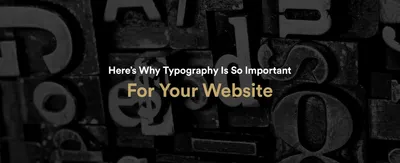Here’s Why Typography Is So Important for Your Website


There’s no two ways about it: The words on your website matter.
But this post isn’t about what those words say; here we’re going to discuss how those words look.
Typography and font-choice cannot and should not be an afterthought when designing and developing a website. They have a far-reaching impact on so many important elements, including user experience, user perception, readability, and even mood.
It is fundamentally important that your designer understands the principles of typographical design, and can deliver a website that communicates your message in a clear and comprehensible manner.
Let’s take a quick look at some of the most important aspects when selecting typography for a website:

There’s certainly a balance to be struck when selecting fonts for your website. If everything is the same, it’s hard to differentiate sections of content, or draw attention to anything in particular.
But if you have too many fonts, your website can become too busy and distracting to be of any benefit to your reader (or your business).
Your best bet is to choose between two and four fonts, and use them with great consideration.


Very few people will sit down and read each and every single word of your content. That’s why the fonts you select need to be readable at a glance.
Think of the way an article or a web page is typically structured:
If any of these three elements are difficult to read, you run the risk of losing your reader before they arrive at the point of your content.
Use your font choices to guide the reader through the page, drawing their attention to important pieces of information, and encouraging them to take some sort of action, such as an enquiry, purchase, or newsletter signup.

Employing too many different colours throughout your content will only serve to confuse your reader. Instead, use colour to draw the eye to certain areas on the page.
Likewise when it comes to formatting. If everything is in bold, then nothing is bold.
And remember, we predominantly read left to right. Use the power of alignment to break up big blocks of text and help guide the reader down the page to your call to action.

Although your branding and colour palette should help position your business in the eyes of a prospective customer, it should also be underpinned by the typography used on your site.
If you’re a creative organisation, you can really hammer that home by being a little bold and out there with your headings. But if you offer professional services, such as finance, accounting, or legal advice, you really ought to steer clear of big swirly letters and odd colour choices.
From the first glance at your written content, the reader should understand the purpose of your website.
So long as your typography and font choices do not detract from this purpose - and as long as they’re readable and used carefully - then you’ve given yourself a platform from which you can confidently craft and share your message.


Need some help with your typography and font choices? You’ve come to the right place. Drop us a line or give us a call on 01942 894 596 to get started.
Hiya, I'm Mike - Web designer at Shape. My articles usually consist of design related stuff.